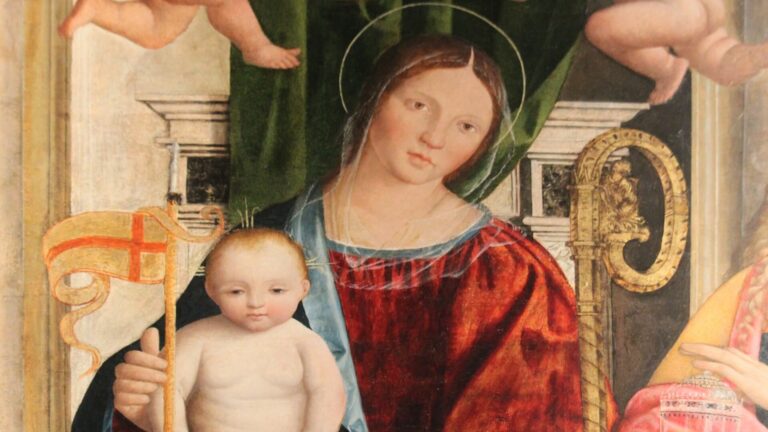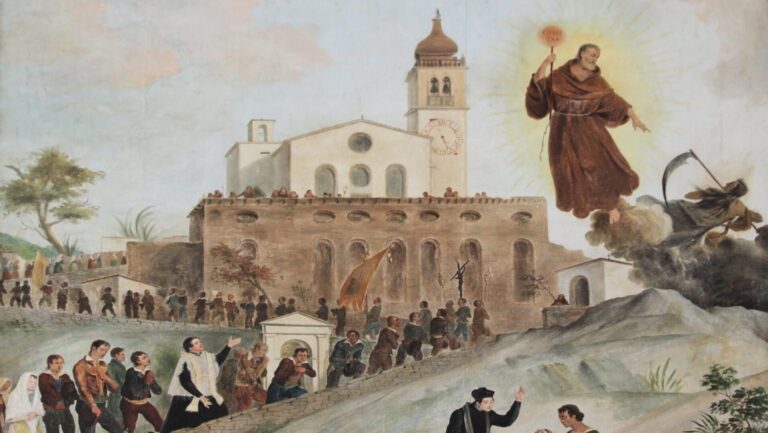ARTISTS’ ROADS
LE VIE DEGLI ARTISTI
watch the videos at the bottom of the page!
REVINE LAGO
1 – FRANCESCO DA MILANO
2 – SANTUARIO SAN FRANCESCO DI PAOLA
1 – Holy Conversation… with Music!
In 1515, Francesco da Milano received payments for the Lago altarpiece, in the municipality of Revine Lago.
The church of San Giorgio, which now houses the work, was consecrated in 1923, but not far away one can still make out the outline of the original building.
The painter’s real name was Francesco Pagani. He arrived in Serravalle in 1502 from Figino, now a district on the western outskirts of Milan.
He was already a skilled artist, trained in the lively Milanese milieu of Ludovico Sforza shaped by the towering artistic figure of Leonardo da Vinci and the monumental project of the Duomo.
But here he was an outsider and so his place of origin became his surname.
He chose to come to the Veneto. The documents do not reveal his reasons for relocating.
However, we may imagine this young painter drawn to see with his own eyes the innovations of Venetian art: a form of painting done without preparatory drawing, dominated by colour, with landscapes playing a central role, conveying atmosphere and emotion.
This was the artistic revolution underway in Venice between the 15th and 16th centuries, with Giovanni Bellini, Cima da Conegliano, Giorgione, and the young Titian at its forefront.
In the Lago altarpiece, the largest work of his early career, Francesco da Milano still shows a strong Lombard influence.
Mary’s face is round, expansive, silent, and elegant. Just like those of the two accompanying saints, Catherine of Alexandria and Mary Magdalene, forming an all-female triptych.
Magdalene’s long, curly blond hair directly references the female portraits of Boltraffio, the Milanese painter who was a close collaborator of Leonardo.
Other elements reveal the painter’s awareness of contemporary Venetian works: the finely rimmed glass Mary Magdalene holds, evoking the alabaster jar of nard, directly recalls the transparency Antonello da Messina captured in 1475 in the San Cassiano Altarpiece. The ornate, pierced crown is a clear citation of the Madonna Salting.
The composition is organised by architecture: a central niche frames Mary’s throne. But symmetry is avoided, and the lateral spaces open up to two small landscapes, blending German graphic detail with Venetian light and atmosphere.
In the foreground, the two male saints, George and Blaise, invite the viewer to turn toward Mary.
Saint George’s luminous armour is rendered with obsessive precision: flanged elbow and knee guards, shaped faulds, wide spaulders, and a long sword with an intricately decorated hilt.
The same level of detail appears in the embroidered red velvet tunic and in Saint Blaise’s wool-carder’s comb, his traditional attribute.
The scene is lively, festive, the brushwork quick, and attention lavished on every detail, without hierarchy.
The true bearers of joy are the four little angels.
The two we notice first, originally placed at eye level, are the musicians: one plays a rhythmic cymbal, the other a sweet melody on a little flute. They offer a foretaste of Paradise, the bliss the faithful may enjoy through the saints’ intercession with Mary.
Above, the other two are busily lifting the green cloth and the crown, symbols of Mary’s royal dignity.
And the banner, Saint George’s attribute, here becomes a foreshadowing of the Resurrection. Its small scale transforms it into a delicate offering, passed from the saint’s hand into Mary’s.
Yet one important thing is missing. The name of the patron, the person we would like to thank for placing his trust in a young painter who was an outsider.
His image is there. Only his name has been lost.
MORE EXPERIENCES!
Francesco da Milano VS Tiziano
- Francesco da Milano, la pala di Anzano
- Tiziano Vecellio, la pala di Serravalle
- Tiziano Vecellio, la casa e il trittico di Castello Roganzuolo
- Francesco da Milano, la pala di Arfanta
2 – Saint Francis of Paola and His Sanctuary. The Work of One, a Legacy for All
Inside the Sanctuary of Saint Francis of Paola is an ex-voto.
It dates to September 1849.
The inscription reads “IN ETERNAL GRATITUDE: REVINE DELIVERED FROM CHOLERA THROUGH THE INTERCESSION OF SAINT FRANCIS OF PAOLA.”
It is a deeply significant image, as it “captures” the architectural complex and its surroundings in the mid-nineteenth century. It also testifies to the profound bond that has developed over time between the local community, the Calabrian saint, and this sacred place dedicated to him.
A crowd in procession follows the zigzagging path leading to the church, accompanied by banners and a crucifix. Some of the faithful have already reached the churchyard. A priest approaches a sick woman and invites her to lift her gaze and pray to Francis of Paola. The saint appears, suspended in a beam of light. He holds the banner bearing the motto CHARITAS, and drives Death away from the community of Revine.
In Venice, that cholera epidemic had claimed thousands of lives in just over a year: “…the plague rages, we lack even bread…” wrote poet Arnaldo Fusinato.
[pause]
In Revine, devotion to Saint Francis of Paola goes back to the seventeenth century and took deep root thanks to a priest, Don Giovanni Cumano, born in Cison di Valmarino and parish priest of Revine for 43 years, from 1676 until his death.
A remarkable and distinguished man, he was the one who, between 1688 and 1702, conceived and funded the construction of this sacred building, dedicated to Jesus, the Virgin Mary, Saint Michael the Archangel, and Saint Francis of Paola.
He built it on the slopes of Monte Frascone, atop a massive wall overlooking the village of Revine. Like a silent, steadfast sentinel.
Soon, six chapels were erected along the path. Together with the oratory, they transformed the ascent into a true pilgrimage: walking, pausing to pray, confession, and the Eucharist were a spiritual journey to obtain indulgence from sin. It is likely that Don Cumano was inspired by the devotional route established in 1642 at the nearby Sanctuary of Saint Augusta.
[pause]
Upon crossing the threshold of the sanctuary, the presence of its founder is immediately felt: his portrait appears on the counter-façade, and his tombstone lies in the floor. This eccentric priest had it carved while still alive, even going so far as to inscribe his presumed date of death…
Inscriptions on the walls explain the profound purpose of this sacred space: a dense gallery of paintings honours the patron saint, Francis of Paola, and a broad company of other saints.
A narrow staircase leads to the upper floor: here is the living space Don Cumano had built for himself.
The room is completely frescoed. One is immersed in the five Joyful Mysteries, from the Annunciation to the boyhood of Jesus. Then a Crucifix. And even glimpses of landscape. These interact playfully with the real landscape, of heart-wrenching beauty, that can be glimpsed through the small windows and stretches over the valley of Lake Santa Maria. And then, a dog, his faithful companion.
In the little chamber, Saint Francis of Paola, naturally. And finally, Death, depicted as a skeleton wielding a scythe.
Since 1936, the sanctuary has been the stage for sacred re-enactments. On Palm Sunday and Good Friday, Revine comes alive, and hundreds of performers enact the Passion of Christ, turning the town into a kind of new Jerusalem. It all begins in the churchyard of the parish church with the Last Supper. The story continues along the ascending path leading to the sanctuary. And there, it culminates with the Crucifixion and Death.
Today, as in the past, the Sanctuary is a steadfast, living presence. A point of reference, even for those who glimpse it from afar.
It is the work of one, but today it is a legacy for all.
MULTIMEDIAL MAP: “ARTISTS’ ROADS – LE VIE DEGLI ARTISTI- EN”!


